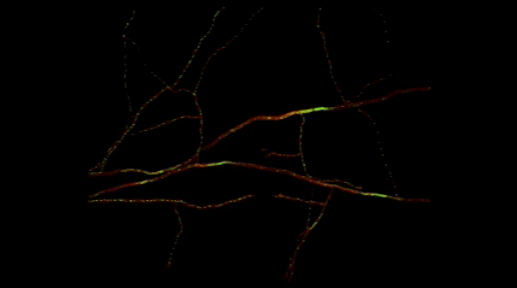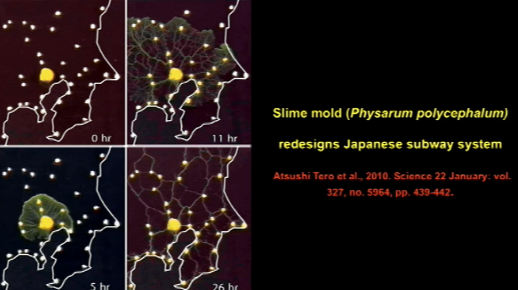Paul Stamets, the visionary mycologist, or mushroom biologist, recently appeared again at the national Bioneers conference. I’ve been following Stamets’s work for some time, and so I eagerly watched his presentation—and then watched it again. The deep wisdom of fungi might just help save life on Earth as we know it.
For those of us not so intimate with fungi, the ones known as mycorrhizal fungi exist underground as a fine network of filaments running through the soil. They may live for tens or hundreds of years digesting oxygen and filtering water and creating conditions ripe for other life before they appear as an above-ground mushroom.
Through this latticework of filaments, nuclei are constantly flowing. Here is a still from a microscopic film (made by Dr. Patrick Hickey of Edinburgh) that traces the movements of nuclei along the filaments:

Captured from Paul Stamets’s Bioneers presentation
A square meter of mycelium might contain trillions of filament ends, where the fungus is constantly sending out its feelers, interacting with its surroundings. If one of its trillion tips finds something interesting—a new nutrient, for instance—it sends the information back through all its channels so that the whole mycelium knows to be on the lookout. Stamets comments,
So I believe that these indeed are neurological networks. These are thinking membranes. They’re literally sensing every footstep you take. And in the aftermath of your footstep, the mycelium reaches forward to gobble up the new nutrients.
Just how smart is the mycelium network? Here is where things get truly astonishing. A group of biologists in 2009 studied the slime-mold species Physarum polycephalum, a gelatinous, single-celled organism resembling a fungus. The researchers drew a figure of downtown Tokyo (the yellow dot in the slide below) close to the ocean (the white outline), surrounded by other urban centers (white dots). They placed the slime mold in downtown Tokyo and yummy slime-mold food (oat flakes) in surrounding areas. Then they waited.
After five hours the slime mold had explored the area immediately around Tokyo, extending its tendrils systematically and randomly in all directions. After eleven hours it had ventured farther, favoring some routes and closing down others that proved to be dead ends. After twenty-six hours it had resolved its myriad pathways into just a few highly efficient ones:

Slide from Paul Stamets’s Bioneers presentation
The slime mold was solving a problem that continually challenges subway system designers: how to find the quickest routes between separate destinations in a transportation system. And the slime mold was doing it all without the benefit of a brain. (So what are our brains for, anyway?)
How does the slime mold accomplish its design miracle? It self-organizes, communicating moment to moment among its constituent parts. Ed Yong at the Guardian explains in more detail:
The plasmodium is a single sac but it behaves like a colony. Every part rhythmically expands and contracts, pushing around the fluid inside. If one part of the plasmodium touches something attractive, like food, it pulses more quickly and widens. If another part meets something repulsive, like light, it pulses more slowly and shrinks. By adding up all of these effects, the plasmodium flows in the best possible direction without a single conscious thought. It is the ultimate in crowdsourcing.
More recently, researchers have found that the tissue structure of the slime mold resembles that of animals—animals usually thought of as “more sophisticated” than slime mold. Moreover, the slime mold accomplishes its cellular self-organizing using two proteins that are similar to those used by animals to organize their own cells.
The Tokyo subway study was published in Science in early 2010. Its lead author, Atsushi Tero of Hokkaido University, believes that studying how the slime mold solves complex design problems could help urban planners solve theirs. He has even developed a computer model of the slime mold’s decision making and set it loose on a map of the United States, published on PopSci. Here is how the slime mold might find its way around the United States:
Paul Stamets adds his thoughts on the Tokyo experiment:
Is it true that these cellular networks are actually intelligent? … When mathematical analysis was applied, they found something astonishing. The mycelium, given these different options, optimized mathematically, making the best possible design that engineers could come up with.
He concludes,
So if you have an engineering hurdle, maybe you should ask a slime mold!

great food for thought
Fascinating. It bolsters my belief that the world is full of things yet to be discovered and that nature is more complex than we ever imagined.
Who knew?! This reaffirms my appreciation for the inventive interconnectedness of living things. Thanks for your lucid explanation of this, Priscilla.